Here are some basic ballet positions explanations and illustrations for you. There are 5 basic foot positions and 5 basic arm positions in ballet – 1st to 5th position in both feet and arms.
Basic Ballet Positions Illustrations
Here are some ballet positions illustrations and descriptions to help you to understand them in your ballet training.
Ballet Positions of the Feet
The first position of the feet is with heels touching and the toes facing outwards.
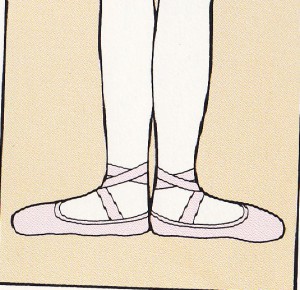
Make sure that both feet are equally turned out from the hips and that they are not so turned out that the feet roll forward. The turnout should come from the hip.
All five toes on both feet must be on the floor and relaxed, not clenched.
Because the arches of the feet are lifted and held, the feet shouldn’t look flat.
The knees should line up with the toes, or face the same way as the toes. On this illustration, the toes are a little too turned out for a beginner, and most people will suffer knee injuries if they do ballet with too much turn out before they are ready and strong enough for it.
2nd Position of the feet has the same rules as the first position but the feet are separated by anywhere from one of your own feet to one and a half of your own feet. The toes are in line with each other and the feet are equally turned out.
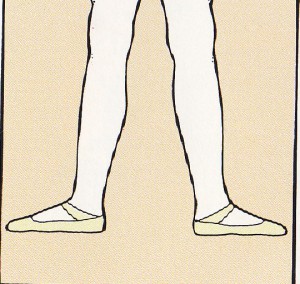
2nd Position is not a pretty position but is used a lot in ballet exercises like echappe sautes and to strengthen the feet in pointe work.
Ballet dancers also do plies in 2nd position and it is the only position in which we plie without lifting the heels.
3rd Position of the feet is more like a stepping stone to 5th Position. It is used to train young children or beginners and is used a lot in the grades exams.
Once a dancer is comfortable with 3rd Position, she then moves on gradually to 5th Position. Professional dancers usually only work from 5th position rather than 3rd.

5th Position of the feet is the ultimate classical position, that you will see all the professionals doing.
It is a difficult position to work in, as the dancer must fully understand how to work the turnout from the hip socket as well as master landings in this position.
4th Position of the feet is a difficult one for dancers to master properly, and both legs need to be turned out equally at all times from the hips, and the weight of the body has to be in the middle, and not favoring one leg. The hips also need to remain square to the dancers front.
There are different variations of 4th position, for instance, 4th opposite 1st is a more open position than 4th opposite 5th. The feet are about a dancers foot distance apart.
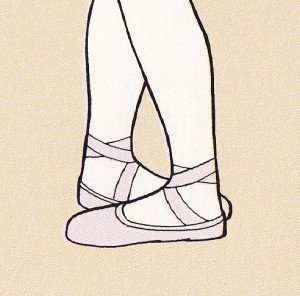

Ballet Positions of the Arms

The first position of the arms that a beginner will learn at ballet is Bras Bas.
In ballet, the arms are always rounded in the basic positions, and they stay in the same shape while moving through all the positions.
Bras bas is not pictured here, but the arms are down with the baby fingers in line with the top of the thigh. The elbows are held away from the body and there is a small gap underneath the armpit.
The upper back should be engaged, and the shoulder blades down.
1st Position of the arms is taken by lifting the arms in front of you so that the middle fingers are in line with the belly button. The elbows are well supported and rounded, and the palms face inwards.
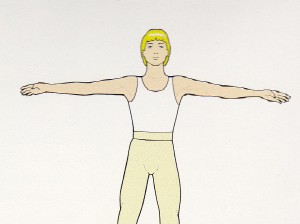
2nd Position of the arms is an open line with the arms sloping gently down from the shoulders. The elbows remain supported and the hands have a soft and relaxed look to them.
The Dancer should feel the muscles across the upper back and underneath the arms working.
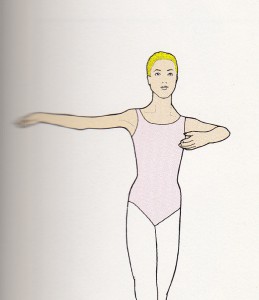
3rd Position of the arms is one arm in 1st and the other in 2nd Position. This position is used to prepare for pirouettes and the arm line shown in the diagram is a bit higher than it should be.
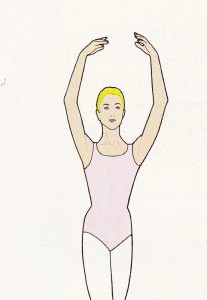
5th Position of the arms is the classic ballerina pose. Both arms are above the head, rounded but lengthened with the shoulders relaxed, and shoulder blades have a feeling of sliding down the back of your spine.
4th Position of the arms is a mixture of 5th position and 2nd position. You also get a 4th crossed position of the arms where the one arm is in 5th position and the other arm is in 1st position.
If you have any questions about these ballet positions illustrations, please leave a comment below.
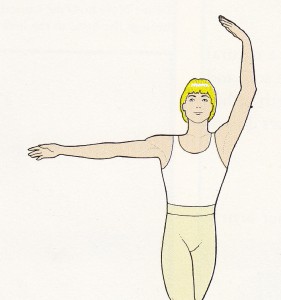


Hello there, and thanks for this awesome article.
It should be of great help to the public as it has been of help to me. I must say that you did a great job on your Illustrations of the arm and feet positions in ballet. I don’t really know much about ballet but after reading your article I fell in love with it. Thanks once more
Thanks for visiting and taking the time to comment on this post. Hope you learnt something you can take away with you.
I wanted to read your article for two reasons. First, my granddaughter is just starting ballet and I wanted to know if the article would be helpful for her. My second reason was selfish. Since she is going to be dancing, I was hoping that by reading your articleI could sound a bit knowledgable when we talk about her dancing. I am wondering why with both the arm and leg positions you mention the 5th position before the 4th. Thanks for the article. It will help my granddaughter and me.
Best of luck to you both and the reason I mention 5th before 4th is that 4th is the least used position and 5th the most.
As an adult learner of ballet, I found this to be very useful and informative. Thank you so much for sharing all these here. The ballet positions you have shared are simply perfect and any beginner must master this before proceeding with anything that has to do with ballet. Thumbs up.
You are quite right, but even so it is best to go to a qualified teacher to learn how to use all these positions with the correct muscle use and posture.